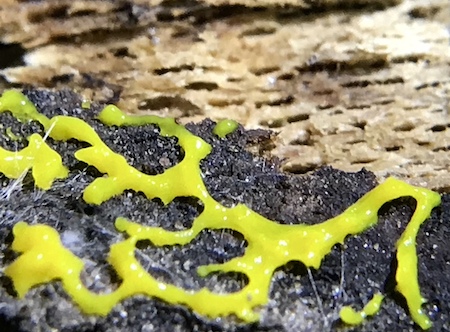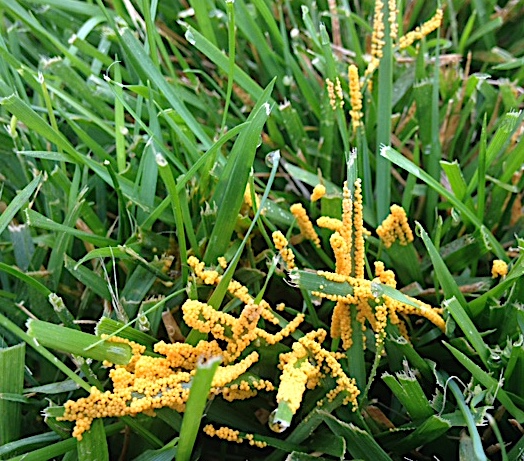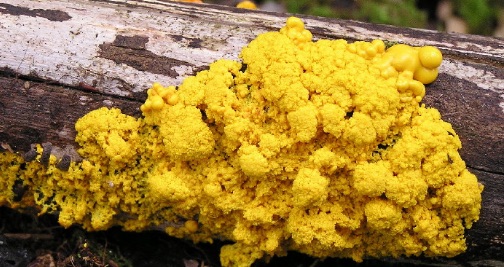What’s That Yellow Blob on my Mulch? Slime Mold
By Ann M. Mason, Fairfax Master Gardener
Slime mold. My first introduction to this fascinating entity was ‘back in the day’ (the 1960s in my case) when my university physics professor engaged in a lively conversation about this curious subject. Today, thanks to recent research, we know a lot more.
Even though we use the term ‘mold’ to describe this blob, it is not a mold. Molds are fungi that break down organic matter into chemicals that are absorbed into cell walls (not ingested). And slime molds are too large to be bacteria.

Physarum polycephalum
Initially, slime mold was thought to be part of the plant kingdom. But now scientists recognize that these yellow or yellow-orange blobs growing across our shady mulch beds are something less prone to a clear classification.
Before I place slime mold into a Tree of Life Classification, I need to reveal ongoing discussions between scientists, taxonomists and others. The consensus on classification has moved away from Carolus (Carl) Linnaeus’ 1735 two Kingdom (Vegetabilia and Animalia) system to reflect the current research and understanding. Now, the 2015 system uses seven Kingdoms (Bacteria, Archaea, Protozoa (Protoctista), Chromista, Plantae, Fungi and Animalia). Classification work continues to our present day. For example, Virginia Tech professor Boris Vinatzer proposes a system based on the genetic sequencing for organisms.
Back to slime molds. What are they? Where do they fit in the Classification Tree of Life?
Slime mold is a single-celled organism. What I mean here is that each blob of slime mold is a single cell! Each single cell contains multiple (thousands and millions of) diploid nuclei that all appear to divide (mitosis) at the same time within the single cell wall. Yep, just one cell with lots of dividing nuclei! In this way the slime mold grows and enlarges. The blob appears to move by reacting to a food (usually) stimulus and contracting its cytoplasm to cause peristaltic waves across the cell. Scientists have measured speed at about 1 mm (0.04 inches) per hour — slow and too small to see distance traveled unless one observes over hours and days. [Note: Speed varies. Some scientists have clocked slime mold moving at up to 5 cm (almost 2 inches) per hour!]

Slime mold on grass
Scientists have moved slime mold from the Kingdom Fungi into the Kingdom Protoctista (protozoa). Within this Kingdom resides the plasmodial slime mold, Physarum polycephalum, in the Phylum Myxomycota. A second type, the cellular slime mold, which is a single-cell amoeboid protist rests in the Phyla Dictyosteliomycota. However, a third type of slime mold, Labyrinthulomycota or slime net, is usually placed into a new Kingdom Chromista (eukaryotic organisms that contain chlorophyll). Note: Eukaryotic cells contain a nucleus and organelles (such as mitochondria, lysosomes and more) enclosed by a cell membrane. In this article we focus on the plasmodial slime mold.
Scientists now estimate that worldwide, there are more than 900 species of slime mold with wide variations in color and appearance. Most plasmodial slime molds are yellow. But some tropical slime molds are bioluminescent and glow in the dark; others are pink.

Slime mold on mulch
Slime molds are found throughout the world usually in shade, on moisture-rich forest leaf litter, mulch, dung and rotting vegetation. Slime molds are fueled by engulfing and ingesting bacteria, yeast and fungus to absorb the dissolved nutrients. Rest easy, gardeners; slime mold is not harmful and does little damage so there is no need for gardener intervention or control.
If nutrition sources decline, or if moisture or temperature conditions turn unfavorable, this single cell can convert itself into a resting state by forming a hardened mass (sclerotia), which is usually brown. If favorable conditions return, it will reactivate. If starvation conditions arise and there is adequate light, it will reconfigure itself to form stalks that produce clusters of fruiting bodies called spores, which are haploid cells (contain half of the genes). Spores are transported by wind, animals or insects. When a spore lands on an optimal site, it fuses with another spore and starts dividing its nucleus. Thus, the life cycle continues, and the plasmodium grows. Note that each spore is the exact clone of (genetically identical to) the parent blob. Spore production is the last gasp for the originating cell, which dies after the stalk and spore production process.
Curious scientists have studied what happens when a slime mold blob is cut into two or more pieces. Not only are the resulting blobs identical genetically, they maintain synchrony — the nuclei in each blob segment undergo mitosis at the same time.
Research on P. polycephalum offers scientists insights into how the ‘intellect’ of organisms without nervous systems works, which in turn might inform the development of artificial intelligence technologies. Specifically, in experiments in which P. polycephalum was placed in mazes, scientists observed that it can find the shortest route to food sources. Researchers have designed mazes using the patterns of interstate highways and electrical grids and observed P. polycephalum finds the shortest route. They observed that P. polycephalum lays down a slime trail and does not repeat use of a non-productive pathway to food. This offers scientists and urban planners new insights into possible ways to optimize routes between points.
Scientific studies into how P. polycephalum moves suggest that there is a signaling mechanism between the location of food source or better environmental conditions, and the contraction and plasma flow within the slime mold’s cell. Some scientists think that creating mathematical models based on fluid dynamics of the slime mold’s movement might inform communication patterns and adaption processes of other non-neural organisms. Other researchers report that P. polycephalum can recognize and react to blue and red colors but cannot differentiate between green and white. Today, researchers are using P. polycephalum as a model-system for research into the information processing and problem-solving, with the hope of adapting and extrapolating the findings to plants, bacteria, fungi — basically, most species on earth without a nervous system.

Fuligo septica (dog vomit slime mold)
So, gardeners, if you see what looks like the yellow Physarum polycephalum, or its cousin, Fuligo septica, the yellowish to whitish bile-looking ‘dog vomit’ slime mold amidst your mulch, you might just have this unique single-celled organism. Lucky you! You will be able to observe and study this unique blob up close.
By the way, it’s reported that this harmless group of organisms inspired the 1950 movie The Blob starring Steve McQueen. And if you are open to viewing a TED talk about slime mold, check it out below.
Resources
• What Humans Can Learn from Semi-Intelligent Slime, Heather Barnett, TED Salon Berlin 2014
• The Blob: Slime Molds, Department of Biology, Utah State University
• Virginia Tech Scientist Proposed Revolutionary Naming System for all Life on Earth, Virginia Tech Daily,
February 24, 2014
• All Hail the Blob, The Smart Slime Mold Confounding Science, Matt Reynolds, Wired UK,
October 19, 2019
• Slime molds: No Brains, No Feet, No Problem, Science, April 5, 2012, PBS NewsHour
• Introduction for the “Slime Molds”, University of California, Berkeley
• Mechanism of signal propagation in Physarum polycephalum, Proceedings of the National Academies
of Sciences (2017)
• The Physarum polycephalum genome reveals extensive use of prokaryotic two-component
andmetazoan-type tyrosine kinase signaling, Genome Biol. Evolution (2016)